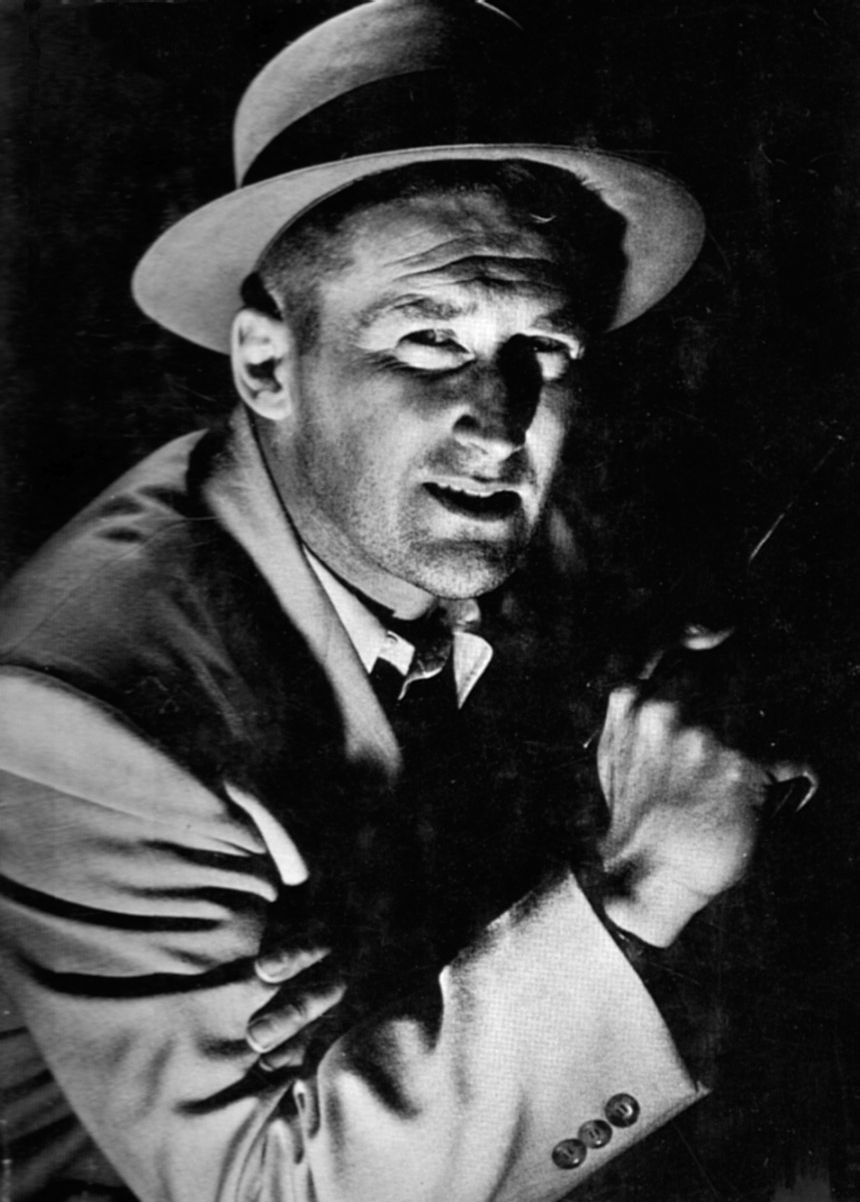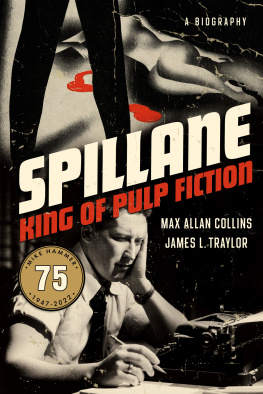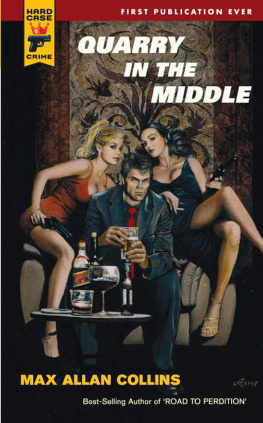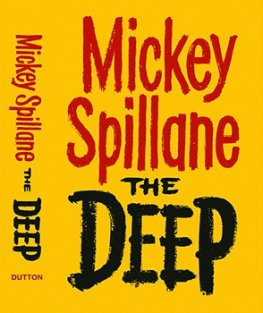Contents
Guide
Page List
SPILLANE
KING OF PULP FICTION
A BIOGRAPHY
MAX ALLAN COLLINS & JAMES L. TRAYLOR

THE MYSTERIOUS PRESS
NEW YORK
For our favorite Veldas
You can kill a man with a hammer
or you can build a house with a hammer.
Mickey Spillane
CONTENTS
S ince the publication of our initial book on Mickey Spillane, One Lonely Knight: Mickey Spillanes Mike Hammer (Popular Press, 1984), we have continued to closely follow and explore the writers life and career. While our Mickey Spillane on Screen (McFarland, 2012) was a logical continuation of our work, the goal has always been to produce a full-scale biography worthy of this fascinating figure who made such an impact on popular culture worldwide.
During Mickeys lifetime, such a biography was impossibleSpillane made it clear to us he intended to one day write his own story. In a sense he did, spending much of his larger-than-life life in the public eye, despite a preference for privacy and a low-key existence. But while he cooperated fully with co-author Collins on an award-winning documentary, Mike Hammers Mickey Spillane (1999), Mickey wrote only a few pages of a long-promised autobiography (included in this book).
As with many, if not all, fiction writers, however, Spillane created through his storytelling a veiled autobiography, written primarily in a colorful first-person point of view, on the one hand invoking a blue-collar, common-man sensibility and on the other a pulp-fiction tough guy argot.
Collins collaborated with Spillane not only on the biographical documentary, but on such projects as the Mike Danger comic-book series and numerous anthologies, and is currently working to finish the wealth of uncompleted novels, stories, and screenplays in the late writers files. (Mentions of Collins in the text will in most cases be represented as MAC.)
Co-author Traylor has continued to write about Spillane in various articles, reviews, and biographical entries (sometimes alone, sometimes with Collins), including for The St. James Guide to Crime & Mystery Writers and The Strand.
Together we have written about Spillane in such magazines as Mystery Fancier, Armchair Detective, Mystery Scene, Journal of Popular Culture, Videoscope, Video Watchdog, and Psychotronic Video.
The authors have corresponded with and/or interviewed an array of individuals notably associated with Spillane. These include Spillanes youngest daughter, Caroline Spillane Hill; Ruth Boyer, his classmate at Kansas State Teachers College, Manhattan, Kansas; Doris Sloan, one of Spillanes young friends from Newburgh, New York; Jon Gerrity, son of writer Dave Gerrity, Spillanes longtime friend, also from Newburgh; George Wilson, Spillanes buddy dating to the days of the Army Air Corps in Greenwood, Mississippi; Don Watts, who became Spillanes friend after the writer moved to South Carolina in the early 1950s and who took more than one hundred trips with Mickey; Harold Cooke, the North Carolina trooper whom Spillane joined on moonshine raids; Gene Powell, adopted by Spillane in the late 1950s; Shirley Eaton, Spillanes costar in the film The Girl Hunters; actress Lee Meredith, the Miller Lite Doll, who shared wonderful stories of her long association with Mickey as a Miller Lite All-Star; TV producer Jay Bernstein, Mickeys Hollywood friend and collaborator; Stacy Keach, star of three Mike Hammer TV series and multiple made-for-television films; Paul Vernon, producer of Mickeys fishing videos and his associate in conservation efforts; and Jane Rogers Spillane, Mickeys gracious widow.
The collected papers and records of publishers E. P. Dutton (at Syracuse University) and Signet/New American Library (at New York University) were likewise at times both fascinating and frustrating. The insight of the editors and publishers at these two venerable houses contributed greatly to our understanding of the Spillane phenomenon.
Together and separately, we interviewed Mickey Spillane on numerous occasions. Uncredited Spillane quotes here are taken from the five hours of interviews conducted by Collins with the writer in 1998 for the 1999 documentary. Ayn Rand expert Shoshana Milgram Knapp provided a recording of Rand and Spillane on Mike Wallaces TV program. Rare prose pieces were shared by dedicated Spillane historians, including Lynn Myers, co-editor with Collins of Primal Spillane, the collected comic-book filler stories. Myers has generously allowed us to include personal anecdotes of his visits with Spillane and his close friends, including Dave Gerrity.
Several film noir historians and devotees have offered help and advice. These include Shadow pulp expert Will Murray, who provided additional clues about the mysterious Frank Morris, whoin the waning years of the pulp magazinescontributed stories that were likely written by Spillane. Pulp historian, novelist, and Spillane authority Stephen Mertzwho knows as much about the writers progenitor Carroll John Daly as anyonewas especially insightful. Special thanks to David McDonald, who joined Traylor on his road trip to visit with Spillanes daughter Caroline, and Robert Berntsen, who served as Traylors tour guide on his trip to visit Newburgh and the apple country of upstate New York.
Various Internet websites provided information, including sites devoted to several actors who portrayed Mike Hammerthe late Darren McGavin, the late Biff Elliot, and Stacy Keach, who has done numerous projects with co-author Collins. Some sites, such as the Internet Movie Database Pro and Turner Classic Movies, are more reliable than others; and Spillanes old high school, Erasmus Hall, and alma mater, Kansas State College, have sites with valuable information about their famous student. (A more complete rundown on Internet sources is included with our bibliography.)
We have from Spillanes personal files hundreds of photos going back to Spillane as an infant, including nearly one hundred photos from the beach and college days. The estate has given access to these photos and approved their use. Other photos come from the collections of Collins and Traylor.
Mickey Spillane inspired the co-authors in many ways: a love of mystery fiction and the tough guy PI; an appreciation of the style of writing known as hard-boiled that has come to be called noir (by way of French film critics referencing publisher Gallimards Serie Noire); and of course our high regard for the talent and artistry of this multimedia giant. At every opportunity, Mickey encouraged our best efforts, all the while sharing his humanity, generosity, and down-to-earth nature. This book reflects not just our love for his work, but for the man, with thanks for his encouragement and friendship.
Certainly that has colored our view of his life and work. Mickey did not sugarcoat his fiction, however, and we hope to follow his hard-nosed lead in the nonfiction ahead.

I n the second half of the twentieth century, almost overnight, Frank Morrison Mickey Spillane became the most popular mystery writer in the United States, rivaled internationally only by Great Britains Agatha Christie.













